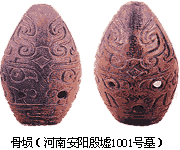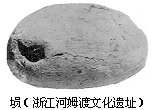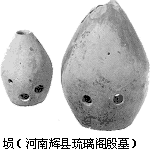X¨±n
 It is one of the important wind instruments in ancient China, evolved from hunting weapons, either as stones throwing at animals or for imitating bird chirping to catch birds. They were mostly made of pottery with the blowing hole on the top, some had no hole for fingers, and some had several. Some were shaped like an olive, some shaped like a fish, there were also ones shaped like a cone. The picture below is one made of clay that can be traced back for over 7,000 years. Being the oldest, it has only one blowing hole and was found at Hemudu Culture site in Yuyao of Zhejiang Province.
It is one of the important wind instruments in ancient China, evolved from hunting weapons, either as stones throwing at animals or for imitating bird chirping to catch birds. They were mostly made of pottery with the blowing hole on the top, some had no hole for fingers, and some had several. Some were shaped like an olive, some shaped like a fish, there were also ones shaped like a cone. The picture below is one made of clay that can be traced back for over 7,000 years. Being the oldest, it has only one blowing hole and was found at Hemudu Culture site in Yuyao of Zhejiang Province.

One pottery Xun discovered at somewhere near Xian is over 6,700 years old and has one hole for finger and can produce two music notes; another pottery Xun discovered in Shanxi Province is circa 5,000 years old, has two holes for finger and can produce three music notes.
Over 20 colored pottery Xun were excavated at the Huoshaogou Culture Site at Yumen of Gansu Province. They have three holes for fingers and can produce four notes of “do, mi, sol, la” in the dianotic system, some can even produce the note of “fa”. It has been reputed as “the remotest civilization in the history of music” after it was played at home and abroad. The picuture on the right is one of those colored pottery Xun.
 When it came to the Shang Dynasty, Xun began to have more note producing holes, the one on the left, that were excavated from Yin Tombs at Huixian of Henan Province, have five holes and can play all the half steps in the octachord.
When it came to the Shang Dynasty, Xun began to have more note producing holes, the one on the left, that were excavated from Yin Tombs at Huixian of Henan Province, have five holes and can play all the half steps in the octachord.
In the classification of music instruments of Zhou Dynasty, Xun was classified as an earthen instrument. It is one of the 29 instruments mentioned in the ¡¶Book of Songs¡·.7-hole Xun appeared in the Han Dynasty. In modern times, Xun was used together with Qin.
The existance of Xun was at risks in the last hundred years. However, Professor Cao Zheng of China Conservatory did a lot in manufacturing Xun by way of imitation. Associate Professor Chen Zhong of Tianjin Conservatory with the assistance of pottery artist Yin Deming successfully made 9-hole Xuns in 1979 that could produce 21 notes. In 1983, Zhao Liangshan of Hubei Provincial Song & Dance Ensemble, on basis of Cheng Zhong’s experience, made 10-hole Xuns, which can easily play the equal temperament and the playing is easy to popularize.
Famous pieces played by Xun are as the following:
¡¶Questioning the Sky¡·
¡¶King of Qin Broke the Army Formation¡·
¡¶The Song of Chu¡·
¡¶Suwu Herding Sheep¡·
¡¶Repetition at Yangguan Pass¡·
